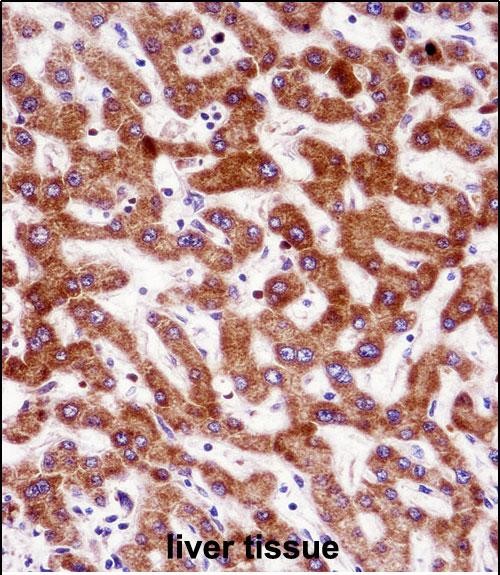IHH Antibody (N-term)
Affinity Purified Rabbit Polyclonal Antibody (Pab)
- SPECIFICATION
- CITATIONS
- PROTOCOLS
- BACKGROUND

Application
| IHC-P, WB, E |
|---|---|
| Primary Accession | Q14623 |
| Other Accession | P97812, NP_002172.2, Q80XI9 |
| Reactivity | Human |
| Predicted | Mouse |
| Host | Rabbit |
| Clonality | Polyclonal |
| Isotype | Rabbit IgG |
| Calculated MW | 45251 Da |
| Antigen Region | 51-80 aa |
| Gene ID | 3549 |
|---|---|
| Other Names | Indian hedgehog protein, IHH, HHG-2, Indian hedgehog protein N-product, Indian hedgehog protein C-product, IHH |
| Target/Specificity | This IHH antibody is generated from rabbits immunized with a KLH conjugated synthetic peptide between 51-80 amino acids from the N-terminal region of human IHH. |
| Dilution | WB~~1:1000 IHC-P~~1:10~50 |
| Format | Purified polyclonal antibody supplied in PBS with 0.09% (W/V) sodium azide. This antibody is purified through a protein A column, followed by peptide affinity purification. |
| Storage | Maintain refrigerated at 2-8°C for up to 2 weeks. For long term storage store at -20°C in small aliquots to prevent freeze-thaw cycles. |
| Precautions | IHH Antibody (N-term) is for research use only and not for use in diagnostic or therapeutic procedures. |
| Name | IHH (HGNC:5956) |
|---|---|
| Function | Plays a role in embryonic morphogenesis; it is involved in the regulation of endochondral skeleton formation, and the development of retinal pigment epithelium (RPE), photoreceptors and periocular tissues (By similarity). |
| Cellular Location | [Indian hedgehog protein N-product]: Cell membrane; Lipid-anchor {ECO:0000250|UniProtKB:Q62226}. Note=The N-product remains associated with the cell surface. {ECO:0000250|UniProtKB:Q15465} |
| Tissue Location | Expressed in embryonic lung, and in adult kidney and liver |

Thousands of laboratories across the world have published research that depended on the performance of antibodies from Abcepta to advance their research. Check out links to articles that cite our products in major peer-reviewed journals, organized by research category.
info@abcepta.com, and receive a free "I Love Antibodies" mug.
Provided below are standard protocols that you may find useful for product applications.
Background
This gene encodes a member of the hedgehog family of secreted signaling molecules. Hedgehog proteins are essential regulators of a variety of developmental processes including growth, patterning and morphogenesis. The encoded protein specifically plays a role in bone growth an differentiation. Mutations in this gene are the cause of brachydactyly type A1 which is characterized by shortening or malformation of the phalanges. Mutations in this gene are also the cause of acrocapitofemoral dysplasia.
References
Meulenbelt, I., et al. Ann. Rheum. Dis. (2010) In press :
Kang, S.J., et al. Hum. Mol. Genet. 19(13):2725-2738(2010)
Okada, Y., et al. Hum. Mol. Genet. 19(11):2303-2312(2010)
Zhao, J., et al. BMC Med. Genet. 11, 96 (2010) :
Chuang, P.T., et al. Nature 397(6720):617-621(1999)
If you have used an Abcepta product and would like to share how it has performed, please click on the "Submit Review" button and provide the requested information. Our staff will examine and post your review and contact you if needed.
If you have any additional inquiries please email technical services at tech@abcepta.com.














 Foundational characteristics of cancer include proliferation, angiogenesis, migration, evasion of apoptosis, and cellular immortality. Find key markers for these cellular processes and antibodies to detect them.
Foundational characteristics of cancer include proliferation, angiogenesis, migration, evasion of apoptosis, and cellular immortality. Find key markers for these cellular processes and antibodies to detect them. The SUMOplot™ Analysis Program predicts and scores sumoylation sites in your protein. SUMOylation is a post-translational modification involved in various cellular processes, such as nuclear-cytosolic transport, transcriptional regulation, apoptosis, protein stability, response to stress, and progression through the cell cycle.
The SUMOplot™ Analysis Program predicts and scores sumoylation sites in your protein. SUMOylation is a post-translational modification involved in various cellular processes, such as nuclear-cytosolic transport, transcriptional regulation, apoptosis, protein stability, response to stress, and progression through the cell cycle. The Autophagy Receptor Motif Plotter predicts and scores autophagy receptor binding sites in your protein. Identifying proteins connected to this pathway is critical to understanding the role of autophagy in physiological as well as pathological processes such as development, differentiation, neurodegenerative diseases, stress, infection, and cancer.
The Autophagy Receptor Motif Plotter predicts and scores autophagy receptor binding sites in your protein. Identifying proteins connected to this pathway is critical to understanding the role of autophagy in physiological as well as pathological processes such as development, differentiation, neurodegenerative diseases, stress, infection, and cancer.



